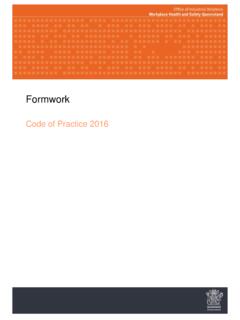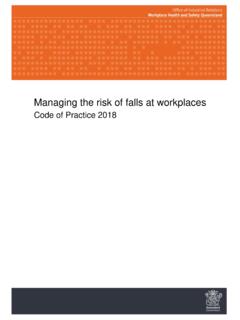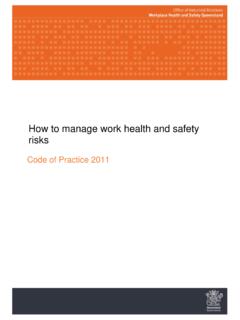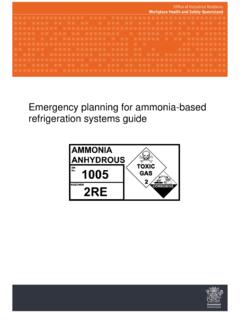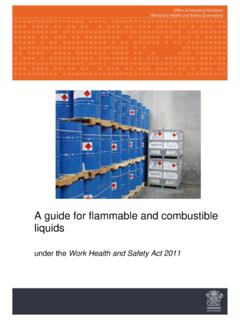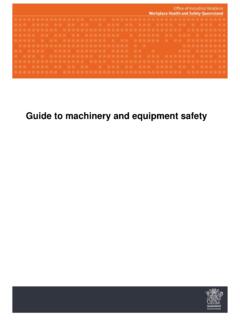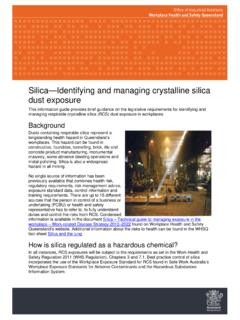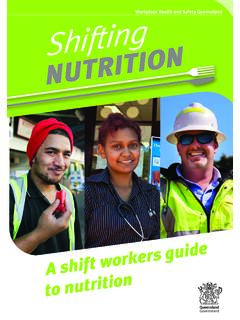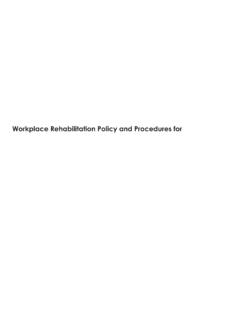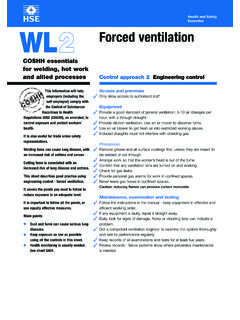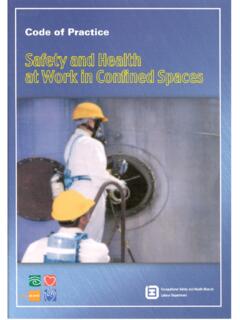Transcription of Confined spaces Code of Practice 2021
1 Confined spaces code of Practice 2021 Confined spaces code of Practice 2021 Page 2 of 54 PN12676 ISBN Creative Commons This copyright work is licensed under a Creative Commons Attribution-Noncommercial International licence. To view a copy of this licence, visit In essence, you are free to copy, communicate and adapt the work for non-commercial purposes, as long as you attribute the work to Safe Work Australia and abide by the other licence terms.
2 Confined spaces code of Practice 2021 Page 3 of 54 Contents Foreword .. 4 1. Introduction .. 5 What is a Confined space ? .. 5 Who has health and safety duties in relation to a Confined space ? .. 7 What is involved in managing risks associated with working in Confined spaces ? .. 10 Information, training, instruction and supervision .. 12 2. Duty of designers, manufacturers, importers, suppliers, installers and constructors .. 14 Eliminating or minimising the need to enter a Confined space .. 14 Entry and exit.
3 14 3. The risk management 16 Identifying the hazards .. 16 What hazards are associated with a Confined space ? .. 17 Other hazards .. 19 Assessing the risks .. 21 4. Controlling the risks .. 25 Eliminate the need to enter a Confined space .. 26 Minimise the risks .. 26 Entry permits .. 27 Isolation .. 28 Atmosphere .. 32 Communication and safety monitoring .. 34 Entry and exit procedures .. 35 Signs and barricades .. 35 Maintaining and reviewing control measures .. 36 5. Emergency procedures .. 38 Appendix A Glossary .. 40 Appendix B Confined space criteria .. 43 Appendix C Sample Confined space entry permit.
4 44 Confined spaces code of Practice 2021 Page 4 of 54 Foreword The Confined spaces code of Practice is an approved code of Practice under section 274 of the Work Health and Safety Act 2011 (the WHS Act). An approved code of Practice is a practical guide to achieving the standards of health, safety and welfare required under the WHS Act and the Work Health and Safety Regulation 2011 (the WHS Regulation). From 1 July 2018 duty holders are required to comply either with an approved code of Practice under the WHS Act or follow another method, such as a technical or an industry standard, if it provides an equivalent or higher standard of work health and safety to the standard required in the code .
5 A code of Practice applies to anyone who has a duty of care in the circumstances described in the code . In most cases, following an approved code of Practice would achieve compliance with the health and safety duties in the WHS Act, in relation to the subject matter of the code . Like regulations, codes of Practice deal with particular issues and do not cover all hazards or risks which may arise. The health and safety duties require duty holders to consider all risks associated with work, not only those for which regulations and codes of Practice exist. Codes of Practice are admissible in court proceedings under the WHS Act and WHS Regulation.
6 Courts may regard a code of Practice as evidence of what is known about a hazard, risk or control and may rely on the code in determining what is reasonably practicable in the circumstances to which the code relates. An inspector may refer to an approved code of Practice when issuing an improvement notice. This may include issuing an improvement notice for failure to comply with a code of Practice where equivalent or higher standards of work health and safety have not been demonstrated. Scope and application This code is intended to be read by a person conducting a business or undertaking (PCBU). It provides practical guidance to PCBUs on how to manage health and safety risks associated with work carried out in a Confined space .
7 This code may be a useful reference for other persons interested in the duties under the WHS Act and the WHS Regulation. This code applies to all workplaces covered by the WHS Act where work is carried out in Confined spaces . How to use this code of Practice This code includes references to the legal requirements under the WHS Act and the WHS Regulation. These are included for convenience only and should not be relied on in place of the full text of the WHS Act or WHS Regulation. The words must , requires or mandatory indicate a legal requirement exists that must be complied with. The word should is used in this code to indicate a recommended course of action, while may is used to indicate an optional course of action.
8 Confined spaces code of Practice 2021 Page 5 of 54 1. Introduction Confined spaces pose dangers because they are usually not designed to be areas where people work. Confined spaces often have poor ventilation which allows hazardous atmospheres to quickly develop, especially if the space is small. The hazards are not always obvious and may change from one entry into the Confined space to the next. The risks of working in Confined spaces include loss of consciousness, impairment, injury or death from: the immediate effects of airborne contaminants fire or explosion from the ignition of flammable contaminants difficulty rescuing and treating an injured or unconscious person oxygen deficiency or immersion in a free-flowing material, such as grain, sand, fertiliser, water or other liquids falls from a height environmental factors ( extremes in temperature) poor lighting manual handling.
9 What is a Confined space ? WHS Regulation section 5 Definitions A Confined space means an enclosed or partially enclosed space that: is not designed or intended primarily to be occupied by a person; and is, or is designed or intended to be, at normal atmospheric pressure while any person is in the space ; and is, or is likely to be, a risk to health and safety from: o an atmosphere that does not have a safe oxygen level o contaminants, including airborne gases, vapours and dusts, that may cause injury from fire or explosion o harmful concentrations of any airborne contaminants o engulfment but does not include a mine shaft or the workings of a mine.
10 A Confined space is determined by the hazards associated with a set of specific circumstances and not just because work is performed in a small space . Entry into a Confined space means a person s head or upper body is in the Confined space or within the boundary of the Confined space . Confined spaces are commonly found in vats, tanks, pits, pipes, ducts, flues, chimneys, silos, containers, pressure vessels, underground sewers, wet or dry wells, shafts, trenches, tunnels or other similar enclosed or partially enclosed structures, when these examples meet the definition of a Confined space in the WHS Regulation. Confined spaces code of Practice 2021 Page 6 of 54 What is not a Confined space for the purposes of the WHS Regulation?
